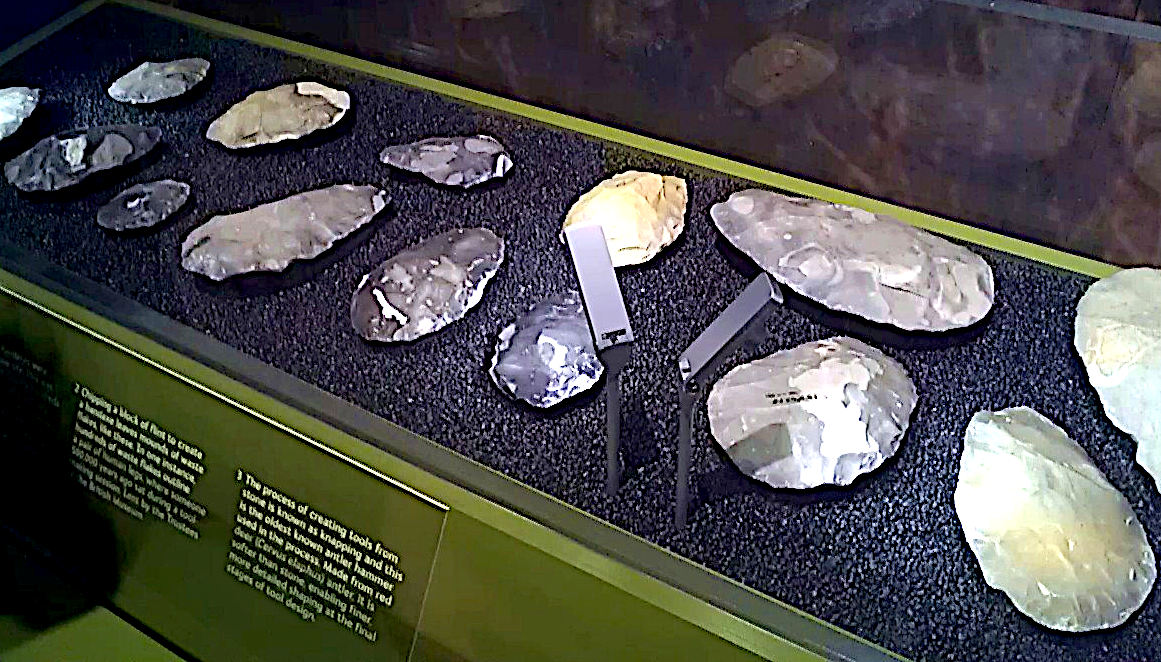
Eartham
Pit was discovered by Dr Andrew Woodcock and Roy Shephard-Thorn in 1974
Boxgrove Man is a name given to three fossils thought to be of Homo heidelbergensis, an extinct relative of modern humans (Homo sapiens), found at Boxgrove in
Sussex, and dated to roughly half a million years old. One piece of the tibia (shinbone) and two teeth were found. The tibia was of a mature well-built man, and the teeth are thought to be of the same mature adult. They are the oldest fossils of the genus homo found in Britain.
Eartham Pit is an internationally important archaeological site north-east of Boxgrove in West Sussex with findings that date to the Lower Palaeolithic.
Only part of the site is protected through designation, one area being a 9.8-hectare (24-acre) geological Site of Special Scientific Interest, as well as a Geological Conservation Review site.
Other key Palaeolithic sites in the UK include Swanscombe, Pontnewydd, Kents Cavern, Paviland, and Gough's Cave.
The site is close to a fossil shoreline that has interglacial mammal fauna in intertidal sediments.
FOSSILS
The site at Boxgrove in Sussex dates to the late Cromerian Stage, around 500,000 years ago, and it is the earliest site in Britain with fossils of the genus homo. The tibia was discovered in 1993 by archaeologist Mark Roberts and his team of the Institute of Archeology at University College London. The two teeth were found in 1995 and 1996 on returns to the site in the hope, which was realised, of finding further remains. The tibia was originally about 40 centimetres (1 ft 4 in) long and is of a well-built male with a height of 177–182 centimetres (5 ft 10 in – 6 ft 0 in). The teeth were lower incisors found about a metre apart and are thought to belong to the same individual, a mature adult. The exceptional structural strength suggests a cold-adapted body with proportions paralleling those of the Neanderthals. Archaeological evidence indicates that these early humans had the ability to hunt or at least scavenge with stone tools as the team discovered hundreds of Acheulean flint tools at the site. The two teeth found show scratches, suggesting an eating technique in which food was cut with a tool whilst gripped between the jaws.
ANTHROPOLOGICAL SITE
Boxgrove in this period evolved from coastal mudflats beneath chalk cliffs to a mosaic of habitats as the sea retreated. There were then areas of grassland, pools, scrub and woodland, with diverse prey and supplies of flint which made the area attrative to early humans. Prey included horse and probably deer. Other mammal fossils were of extinct species of rhinoceros, bears, and voles. It is most likely that H. heidelbergensis hunted these animals for sustenance with the aid of the stone tools also discovered at this site. There is clear evidence on the animal remains that they were butchered, but it cannot be proven that the species whose fossil was found in association with them hunted these animals or scavenged them. Teeth marks on the tibia fossil may be evidence that he or she was scavenged as well, either by cannibalism or scavenging by another animal.

Since
Homo Habilis, the development of man from the Australopithecines
emanating from Olduvai Gorge, Tanzania, has been relentless, one of the
connecting features being the ability of our ancestors to make and use
tools. Olduvai Gorge is a paleoanthropological site in the eastern Serengeti Plain, within the boundaries of the Ngorongoro Conservation Area in northern Tanzania. It is a steep-sided ravine consisting of two branches that have a combined length of about 30 miles (48 km) and are 295 feet (90 metres) deep. Deposits exposed in the sides of the gorge cover a time span from about 2.1 million to 15,000 years ago.
The deposits have yielded the fossil remains of more than 60 hominins (members of the human lineage), providing the most continuous known record of human evolution during the past 2 million years,
a DNA
bonanza for anthropologists like John
Storm, as well as the longest known archaeological record of the development of stone-tool industries. Olduvai Gorge was designated part of a
UNESCO World Heritage site in 1979. Although Olduvai Gorge has often been called the “Cradle of Mankind,” a different World Heritage site called the “Cradle of Humankind” is located in South Africa. Compare Sterkfontein, Swartkrans, and Kromdraai.
EXCAVATION HISTORY
The Boxgrove site was first discovered by the archaeologist Andrew Woodcock and the geologist Roy Shephard-Thorn in 1974. During the first stages of gravel extraction, their investigations showed a series of marine deposits, overlain by gravels, were preserved within the quarry.
Dr Woodcock recorded exceptionally well preserved Acheulean artefacts and mammalian fauna at the intersection between these sediments and determined the potential importance of the site.
Dr Woodcock went on the become the County Archaeologist with East
Sussex County Council, where he contributed toward the process of
archaeologically surveying the Generating
Station at Herstmonceux, eventually leading to recognition of the
monument and inclusion on the Historic
Environment Record at TheKeep.
Between 1982 and 1996 a series of excavations were undertaken at the site by the UCL Institute of Archaeology with funding from Historic England. The excavations were directed by Mark Roberts of the UCL Institute of Archaeology, with successive co-direction by Martin Bates and Simon Parfitt.
In 2011, Roberts told interviewers from the student-produced archaeological magazine Artifact that Boxgrove was "a fickle mistress indeed" and that whilst he wouldn't change his experience in investigating the site, the excavations "extracted a very heavy price" from him, "a price that I am only just at the point of paying the final
installment on". For this reason he found that he often hummed The Specials' 1979 song "Too Much Too Young" to himself when thinking about the project.
LINKS
& REFERENCE
https://www


